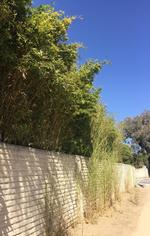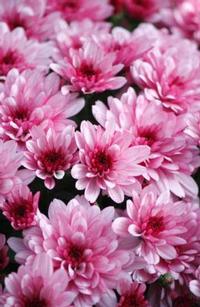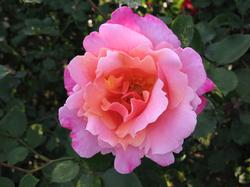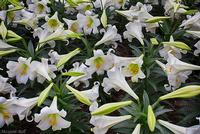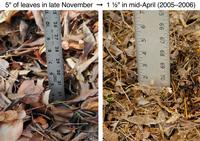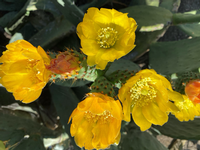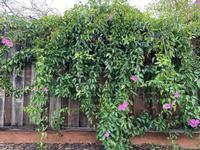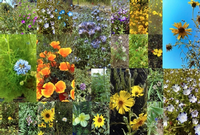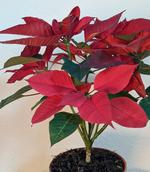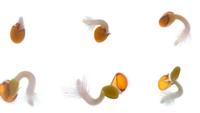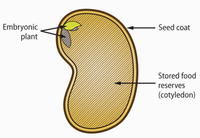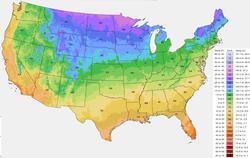Ornamentals
Ornamental plants add beauty to our yards. Below is a collection of our monthly tips that relate to ornamental plants.
Ornamentals Tips
Aloe Plants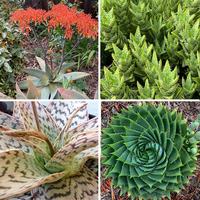
Clockwise from upper left: Aloe striata (coral aloe), Aloe juvenna (Tiger Tooth Aloe), Aloe polyphylla (spiral aloe), Aloe ‘Delta Lights’
You can see their dramatic stalks of flowers here. Photo: Aloe flowers, clockwise from upper left: Aloe ferox, Aloe striata (coral aloe), Aloe polyphylla (spiral aloe), Aloe ‘Rooikappie’ |
Amaryllis or is it Hippeastrum?
Brighten the holidays with Amaryllis (Photo: UC Solano Master Gardeners)
|
Arboretum All-Stars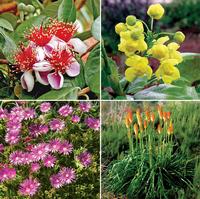
Clockwise from top left: pineapple guava, compact Oregon grape, Christmas cheer poker plant, Cooper’s ice plant, UC Davis Arboretum
More Information: UC Davis Arboretum All-Stars
|
Attracting BeesBees are pollination workhorses, increasing garden production. Many plants will not produce fruit unless flowers are pollinated. Colorful annuals, such as Cosmos, edible African Blue Basil, and Salvias attract bees. You can also allow herbs and other plants to flower to create bee-friendly landscapes. The University of California at Davis has a garden dedicated to bees. The Honey Bee Haven website has more resources, including a list of plants they grow. |
BambooBamboo has a reputation for spreading out of control, but not all varieties are classified as running bamboo. There are clumping bamboos that are easier to contain. Bamboo is grass, albeit one that can grow over fifty feet tall. Tall bamboo is often used as a privacy screen. It does best in full sun or partial shade. It is fairly drought tolerant and is an easy plant to grow. Deep barriers may be able to keep it from spreading. If planting in a container, check regularly to make sure the roots are not escaping from the drainage holes and thus growing beyond the pots into your yard or your neighbor’s. Foothill College in Los Altos Hills has a bamboo garden with over 80 varieties of bamboo if you’d like to see how many different ways bamboo can grow.
More information: Growing bamboo |
Bare Root Plants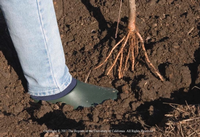
The bare roots should be soaked from an hour to overnight (large plants) in a bucket of water before planting. Trim roots of broken, dead, or spongy bits and carefully pull the roots apart. Dig a hole that is fairly shallow and wide. Spread the roots out sideways and have the crown of the plant several inches above the soil level. This is necessary as the plant will settle down over time. Water in well but wait to fertilize until you see new shoots growing. Be sure to water regularly if the rains are sparse. Staking may not be necessary. Trees aren't the only plants that are sold bare root. You can also plant bare-root asparagus, artichokes, rhubarb, berries, kiwifruit, horseradish, rhubarb, grapes, roses, strawberries, and iris in January. More information: Planting Bare-Root Fruit Trees |
Bare Root RosesJanuary and February are ideal for planting bare root roses. When you choose roses, the American Rose Society can help you navigate the 150 species and thousands of hybrids. Besides color and growth form, you may also consider the balance between scent and appearance. Many of the older roses are highly fragrant, while many newer roses are bred for beauty and large blooms. Consider the susceptibility of roses to many diseases when choosing a spot in your garden. They do best with six hours of sun, in well-drained soil, with good air circulation, and without overhead watering. When planting, mix organic material with native soil in the planting hole. Make sure the base of the plant remains an inch or two above the surrounding soil so that water doesn’t accumulate around the crown. Water thoroughly immediately after planting.
More Information: Selecting and Planting Bare Root Roses
|
Bone Meal for Bulbs?Bone meal has traditionally been used as a phosphorus source for flower bulbs, but you may want to reconsider. If your soil is healthy, you may not need it and you may be better off with a balanced fertilizer designed for bulbs or even nothing at all. The nutrient content of commercial bone meal is lower than in the past due to the cleaning process, and the bone smell may attract raccoons or dogs to dig up the bulbs. |
California Natives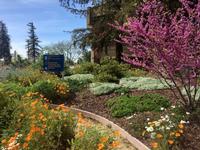
More Information:
|
California Poppies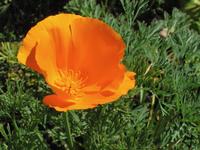
It can re-grow from a taproot or reseed itself rapidly throughout your garden and lawn, so consider whether this would be acceptable. If it is, seeds can be scattered now or with initial rains for vibrant color in a couple of months. |
Camellia Petal Blight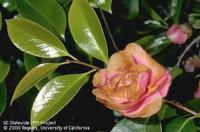
More information: Camellias Petal Blight |
Camellias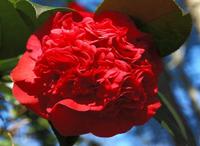
More information: Camellia Pests |
ChrysanthemumsThis is a less common but good time to plant chrysanthemums. They will have plenty of time to develop a good root system before the cold winter and are more likely to bloom perennially in your garden than if they are started in the fall. You can also start chrysanthemums from cuttings. Plant them in amended, well-drained soil, or grow them in a large container. Keep them moist but not wet. They do well in full sunshine, yet a little afternoon shade is fine in hot areas. If you pinch the growing tips as they grow, they will branch and be bushier. Otherwise, be prepared to provide support if they grow tall. Also, pinching off some of the buds will result in fewer yet much larger blooms. There is a Bay Area Chrysanthemum Society for local information and sharing.
More Information: Chrysanthemum Disorders and Pests
|
Creating a Pollinator GardenPollination is the process of transferring pollen from the anthers of a flower to the stigma. It is a requirement for the production of fruits and seeds. In addition to wind and water, pollinators include bees, hummingbirds, butterflies, moths, bats, flies, and beetles. You can support the pollination process—and help counter habitat destruction—by selecting plants attractive to common pollinators. UC has many resources for planning a pollinator garden. Here are a few to get you started!
|
DeadheadingDeadheading means removing spent blossoms from your plants. Not all plants need deadheading, but if the flowers stay on the plant and become unattractive (think roses, dahlias, marigolds, coneflowers, geraniums and many more), then consider a little pruning. The technique varies by plant; some spent flowers can be snapped off by hand (dahlias), others are better done with hand pruners (roses), and some can be sheared off all together (lavender). You'll not only make the plant look better, you'll stimulate additional blooming for plants that have a long blooming season. |
Decay in TreesShelf-like fungus or mushrooms growing on trees indicates advanced internal decay. Once these external fruiting structures appear, the infection is likely widespread inside the tree. To reduce the chance of infection, protect trees from injury, provide adequate water and fertilization, and prune trees correctly when young to avoid significant pruning cuts when they’re older. Regularly inspect trees and consult an arborist if you spot fungal growths or other signs of decay. The arborist can assess the extent of rot and the structural integrity and make recommendations. More information: Wood Decay Fungi in Landscape Trees |
Don't Plant an Invasive PlantAccording to PlantRight, so-called invasive plants "escape into open landscapes and cause a variety of ecological problems. They displace native plants and wildlife, increase wildfire and flood danger, clog valuable waterways, degrade recreational opportunities, and destroy productive range and timberlands." PlantRight has identified the following as invasive in Northern California: Green fountain grass (Pennisetum setaceum), Periwinkle (Vinca major), Pampas grass (Cortaderia selloana), Highway iceplant (Carpobrotus edulis), Mexican feathergrass (Stipa / Nassella tenuissima), Yellow Flag Iris (Iris pseudacrorus), Water Hyacinth (Eichhornia crassipes). With just a little research you can avoid using plants that are unfriendly to the Bay Area.
|
Dormant Rose PruningWinter is the best time to prune roses even if they haven’t gone completely dormant. The old advice was to cut the canes down drastically, but that isn’t necessary for our climate. Instead, just cut back about one-third to one-half of the total height. In other words, take a 4-foot bush down to about 2–3 feet. When cutting back a cane, make the cut at an angle just above an outward pointing bud. Take out any dead or diseased canes, remove suckers below the graft union, and branches that are crossing or growing towards the middle of the plant to improve airflow. Clean up old leaves on the plant and ground to reduce rust and black spot.
More Information: Rose Care |
Drought Tip - No Fertilizer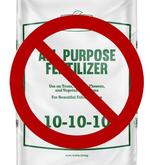
More information: Skip fertilizing |
Easter LiliesBeautiful white Easter lilies are normally everywhere this time of year – in nurseries, on Easter dinner tables, and in churches. How do they all come into bloom every year just in time for the moveable Easter holiday? The blooms are forced in commercial growing operations with greenhouses carefully controlled for temperature, light, and moisture. 95% of the bulbs are started in ten farms along the California-Oregon border. The plants are native to Taiwan and Japan and were first described in a Japanese gardening book in 1681. You can plant them outdoors after Easter in moist, well-drained soil with partial sun. Their natural cycle will lead to blooms closer to June in subsequent years. Just don’t let your cats eat them!
More Information: Easter Lily diseases
|
EcheveriaIt's easy to have color in your yard without using a lot of water. Instead of planting thirsty annuals, consider some of the many types of succulents. Echeveria does well in containers or in the ground. Plant them in well-drained soil and allow the soil to dry between waterings. They aren't particular about sun or shade, although some can be a little sensitive to full afternoon summer sun. |
Encouraging Dahlia BloomsFirst, make sure those tall flowers have support so they don’t flop over or break off. Disbudding—removal of all but the central bud on each stalk—will result in larger more spectacular flowers. Deadheading—cutting the spent flowers back to one node below the bloom before they can set seeds—will encourage lateral blooms. Water the plants regularly, and continue to apply low nitrogen fertilizer throughout the summer.
Fundamentals of Growing Dahlias , American Dahlia Society
|
Extending the life of cut flowersUse lemon-lime soda or lemon juice to extend the life of cut flowers. The following mixtures supply food for the flowers and enough acidity to deter microbial activity.
For more information, refer to Extending the Freshness of Cut Flowers at Home. |
Fall Garden CleanupIt’s an excellent idea to keep the garden clean at all times and to remove dead or dying plants or diseased material. Yet there may be bigger seasonal cleanups when taking out plants that have finished producing or that need to be removed to make room for new plants. Trim woody or overgrown perennials. Remove plant debris that allows insects and diseases to overwinter and then reproduce. Always pick up fruit promptly from the ground to not invite critters or allow diseases to proliferate. It's best to leave fallen leaves in place unless they are diseased. They provide a mulch layer while slowly breaking down and returning nutrients to the soil and then back to the plants. Particularly during a drought, having the soil covered is important for moisture retention. If the leaves are diseased, they need to be removed and put out with the yard waste. Monitor the health of your plants while you're out cleaning up.
More Information: Fall Garden and Landscape Checklist
|
Fertilizing Ornamentals During DroughtOne way to manage plants during drought is to reduce the amount of fertilizer used. While plants need nutrients to survive and be healthy, excess fertilizer promotes additional growth, which then demands more water. |
FirescapingAfter a dry winter, we must be careful about the fire season. Choosing plants carefully and maintaining them well can help to reduce the risk, especially for homes closer to the hills or actually in the hills. Two relevant landscaping principles are fuel reduction and fire path interruption. With fuel reduction, choosing succulents or other water retaining plants will slow a fire down. On the other hand, plants that are dry or have high oil content, such as eucalyptus, juniper, and pine, give the fire fuel to burn hotter and faster. Interrupting the fire path involves spacing plants to avoid a line along which a fire can easily travel. Minimize plantings close to the house. East Bay Municipal Utility District offers a free firescaping booklet that you can download from their website.
More Information: Firescaping Zones
|
Flowering VinesVines are plants that climb or sprawl and can easily outgrow their spaces if not pruned annually or more often. Many are pruned in the winter when they are dormant. This reduces shock to the plant and allows you to better see the structure when pruning. If the vines are flowering, wait until after the blooms have finished. Some vines get cut back almost to the ground to renew them. Some are cut back to the beginning of the herbaceous growth, leaving the woody vines. Others are pruned simply for shape or size. The UC Davis Arboretum All-Stars brochure includes several flowering vines. All-Stars are plants that have been tested and proven to thrive in California. The brochure lists pruning needs. It also has photos, characteristics, and requirements of the plants if you are looking for new plants.
More Information: Marin Master Gardeners: Vines
|
Flowers To Attract Beneficial InsectsCertain flowers help attract natural enemies of pest insects in the garden. Tiny wasps that parasitize certain insect pests or their eggs need pollen and nectar to survive. Predatory insects (syrphid fly larvae, lady beetles, lace wings, and many others) and mites survive on pollen and nectar from flowers when pest populations are low, and some feed on pollen in order to reproduce. Most of these beneficial insects are small, and so the best flowering plants to include in the garden are those that have small flowers that have pollen and nectar easily accessible and that bloom throughout the season. Avoid flowers that are difficult to weed out when they reseed. Many flowers that attract beneficial insects are easy to start from seed and this month is a good time to start them – some indoors any time or outdoors later in the month after frost danger has passed. Examples include sunflowers (try dwarf varieties like ‘Sunspot’ for smaller spaces), calendula, cosmos and many herbs like dill, basil and borage. Other flowers and herbs that attract beneficial insects are easier to buy as plants. A few examples that can be planted this month are coreopsis, asters, and thyme. Reference info: |
Fresh Cut Flowers from Your Garden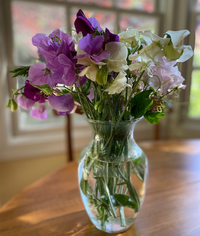
More information: Tips on planting a cut flower garden |
Geranium CareGeraniums need very little water. Too much water can lead to stem rot, or, if combined with too much fertilizer, more leaf growth than flowers. Geraniums prefer a dry location. If this isn't possible, try growing them in pots. |
Going NativeNative shrubs, trees, and flowers are well-adapted to our climate and soil, and support native butterflies and bees and other wildlife. They are drought-tolerant once they are established, but need adequate water for the first year or two to establish a strong root system that will help nourish the plant for years to come. Planting them in the fall gives them time to settle in before being hit by the heat of the summer sun. Consult Water Wise Plants and the California Native Plant Society for more information. |
Gray Mold (Botrytis)Botrytis is gray or brownish fuzzy mold that can attack a wide variety of plants. It likes flower petals, ripening fruits and vegetables, as well as leaves and stems. The spores are spread through the air. It is most severe when there's high humidity and may start forming on decaying matter. According to the UC Pest Note on Botrytis Blight, it is important to remove debris and prunings from the ground. You may even have to pick up flowers daily. Avoid overhead watering. UC also has information about Gray Mold on Strawberries. |
How to Attract and Maintain Pollinators in Your GardenUC ANR has a publication titled "How to Attract and Maintain Pollinators in Your Garden" that discusses the benefits of providing flowers for pollinators and has a list of pollinator plants that are successful in most California gardens. |
Irrigate in Circles and Spirals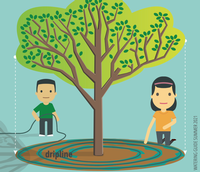
For more information: Help Your Trees Survive the Drought |
Keep Foliage after Bloom Fade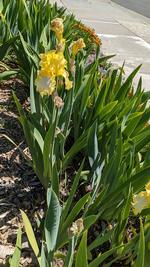
If the plants seemed crowded and the flowers were getting smaller, carefully dig them up, separate the bulbs, and replant them with greater spacing. Toss any bulbs/corms/rhizomes/tubers More information: Basic Bulb Care |
Mulch to Conserve Water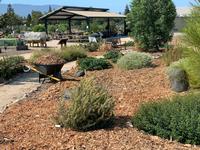
More information: Mulching with Organic Materials |
Native Wildflowers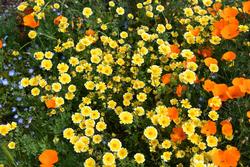
More information: Native Wildflowers |
Neem Oil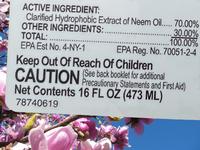
More information: More about Neem |
OleanderThese plants are obviously not terribly picky about conditions if they live and thrive in freeway medians. Oleander is drought tolerant once established. They rarely, if ever, need to be fertilized in our local soils or sprayed or pruned. But if you want to prune them to fit into a small yard space or to make them look like a tree rather than a bush, you can do so now. As with all pruning, first cut out any dead or dying branches. Then cut any that are deformed or growing in an undesirable direction. After that, you can prune for size and shape. Cut the plant back to a little smaller than the size you ultimately want, keeping in mind that it will re-grow. Take care not to prune off more than one-third of the plant at a time. Make cuts above nodes that face out in the direction in which you want new growth to go. All parts of the plant are poisonous so do not eat it, burn it, or work on it without gloves. The good news is that this latter quality makes it deer resistant.
More Information: Oleander article, Tulare/Kings County Master Gardeners
|
Perennials and Bunch GrassesWinter is a good time to cut back perennials and bunch grasses. You can cut back some perennials all the way to the ground. These include yarrow, hummingbird sage, goldenrod, California aster, and most kinds of California fuchsia. You can divide other perennials at this time, such as Douglas iris, alum root, seaside daisy, woodland and beach strawberry, yarrow, yerba buena, daylilies, and chrysanthemums.
You can propagate bunch grasses, sedges, and rushes by division this time of year. Examples of bunch grasses are purple needle grass (state grass of California), fescues, blue grama, leafy reed, oat, and deer grass. Some sedges are the meadow, clustered field, and San Diego sedge. Rushes include the common rush and the California gray rush.
|
Pinching Flowers and Herbs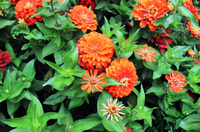
More Information: Pinching Flowers and Herbs
|
Plant Native Shrubs and FlowersNative shrubs like manzanitas, silk tassel bush, and currants come into bloom and provide nourishment for wildlife at the height of winter. These carefree, water-wise shrubs look good throughout the year. Winter is still a good time to plant native plants. It is not too late to scatter wildflower seeds like California poppy, mountain garland, baby blue eyes, globe or bird's eye gilia, clarkias, lupines and tidy tips. Make sure the seeds have good soil contact by walking or tamping on the seeded areas. Consider planting native bulbs like wild hyacinth, mariposa lily, harvest brodiaea or soap plant in areas that remain dry through the summer, perhaps at the feet of established shrubs. If you've had California poppies before, they'll start popping up all around as a result of winter rains. If you're interested in brilliant orange spring color, you can still scatter seeds now. When choosing a spot to plant them, keep in mind that they re-seed themselves readily and they can smother nearby small plants. |
Planting Bulbs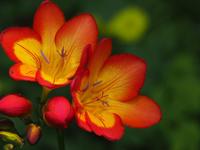
Freesia flowers
Be sure to plant them with the pointy side up because new growth will come from that point. A rule of thumb is to plant them twice as deep as the diameter of the bulb, but follow instructions for the specific flowers. Water them in at planting time. More Information: Bulb Planting Schedule , Tips for Growing Bulbs |
Planting OrnamentalsSpring is when thoughts turn to planting, yet fall is an excellent time to plant perennials. You can plant many trees, shrubs, and other long-lasting plants in the fall. This applies particularly well to California native plants. Putting them in now will give them a chance to start developing strong root systems with the winter rains before they are stressed by summer heat. Make sure to water new plantings regularly until they have established good root systems and can survive with less supplemental water.
When choosing plants, consider our general Mediterranean climate as well as the microclimate of your yard. Local California natives in particular need little to no amending of the soil because they have evolved in our clay soils. Sun times, water needs, wind exposure, and soil type can all impact the success of a plant. Make sure you know how large the plant will become, even if it looks fine now in a one-gallon or five-gallon container.
More Information: Mediterranean Plant List
|
Plants to Attract ButterfliesButterfly populations fluctuate in response to climate and habitat conditions. Many have specific host plants on which they feed and breed. Some common plants for attracting butterflies are milkweed, lantana, buddleia, and zinnias. For an extensive list of relationships between specific butterflies and host plants, see Art Shapiro's Butterfly Site at UC Davis. |
PoinsettiasPoinsettias are tropical plants, so they'll do best in a warm, sunny place in your house. The soil can easily dry out and become hydrophobic, so make sure to check the soil moisture regularly. There’s really no need to fuss over them if you’re only keeping them for a few weeks of holiday color. If you want them to bloom again next year in time for the holidays, UC has Poinsettia Care Tips that describe what to do; just be aware that it is a little tricky.
Did you know that the red parts are actually bracts (modified leaves) and that the true flowers are the little yellow parts in the centers? You can also plant them outdoors with protection from frost. They have been seen growing as tall as eight feet in San Jose, and taller in their native Mexico. |
Poisonous Plants ListAs we approach the holidays, there are a lot of questions on poisonous plants. Fortunately, many of these plants have a very bitter taste that limits the amount of the plant eaten. Poinsettia and mistletoe should be kept away from curious children, but the list includes other flowers and plants such as azaleas, calla lily, carnation, daffodil, foxglove, hydrangeas, iris, lantana, narcissus, poppy, sweet pea and tulips. Different parts of the plant may be toxic. Consult the UC Poison Plant web page for detailed information. |
Potting Mix vs Planting Mix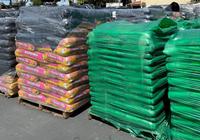
For more information: Bagged Potting Mixes |
Pruning Azaleas and RhododendronsAzaleas and rhododendrons can be pruned as soon as they finish flowering. This is also a good time to fertilize them. Choose an acid-forming fertilizer blended for these particular plants, and be sure to follow the label directions for amounts. Learn more by visiting the Azalea and Rhododendron society websites. |
Pruning BougainvilleaYou can prune at any time to shape or direct growth. If it is growing on a wall, cut back long stems to keep producing flowering wood. Hard pruning to renew the plant should be done in the spring after the last frost. |
Pruning California NativesIf your landscape includes California native plants, you may wonder if you should prune them. It depends. Some don’t respond well to shaping or shearing to control size. But they do like careful pruning at the proper time, which is when they are dormant. That could be either summer or mid-winter. Natives that do well with winter trimming include California buckeye (Aesculus californica), honeysuckle (Lonicera hispidula), and salvia species. California fuchsia (Epilobium canum) and lilac verbena (Verbena lilacina) can be cut almost to the ground. But wait until summer for grasses and broadleaf evergreen shrubs and trees. More information: How to Prune California Native Plants |
Pruning CamelliasApril and May are the best time to prune camellia. Camellia should be pruned just after flowering and before new vegetative growth gets going. If you prune later in the season, you risk damaging next years blossoms. |
Pruning FuchsiasThe time to prune fuchsias is early spring, after the chance of frost is past. If there is frost damage prune it out and take off some of last summer's growth. Leave at least two or three healthy leaf buds on each branch. Fuchsias have a tendency to get leggy. Frequently pinch the tips of the branches during the spring and summer to force side growth, making the fuchsia bushier. Pick off flowers as they fade. More information: UC IPM list of common pests and disorders of fuchsias. |
Pruning HydrangeasFor better-looking hydrangeas, prune out the spent blossoms. Hydrangeas are fast growing and need pruning to control size and shape. Cut out the older stems that have flowered, leaving the ones that have not flowered. For the biggest flower clusters, reduce the number of stems. For lots of medium size flowers, keep more stems. |
Root Knot Nematodes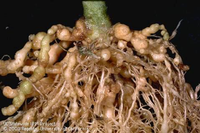
More information: Nematodes Pest Note |
Rose CareRoses are notoriously susceptible to many diseases, including rust, black spot, and powdery mildew. For this reason, they are often planted at the edges of vineyards to give an early warning about diseases that can affect the vines. Yet not everything that negatively impacts roses is a disease or pest, so don’t automatically reach for the chemicals. Abiotic disorders are caused by nonliving factors and can be addressed with cultural changes. Blackened areas on canes can be from sunburn. Brown-edged leaves may signal a high concentration of salt in the soil. Yellow leaves may be due to nutrient deficiencies. Deformed growth may be due to exposure to glyphosate, the active ingredient in Roundup. Good air circulation allows the morning dew to dry, and helps prevent rust and powdery mildew. Some practices to keep your roses healthy are to choose hardy varieties, enrich the soil with compost, fertilize regularly but not too much, irrigate directly to the root zone, and remove suckers (the rapid-growing, long canes) from roses. Prune them below the bud union.
|
Seed ViabilitySeed packets have a “packed for” date on the back. Yet seeds can still be viable for years beyond that date if stored correctly. Ideal storage conditions are cool and dry. The older the seeds are, the lower the germination rate will be. So plant more of the older seeds than the number of plants you ultimately want. You can do a germination test by putting seeds on a damp paper towel and enclosing them in plastic to keep them uniformly moist. Do this right before planting time so you can transplant the ones that successfully germinate. Or you can take your chances and just plant them directly and see what comes up. If you are saving your own seeds, make sure to choose seeds from the healthiest plants.
Whenever it's hard to find flower seedlings, if you have some old flower seed packets, you can scatter the seeds randomly in a section of your yard and enjoy whatever flowers. More Information: Vegetable Seed Viability
|
Selecting SeedsWhile curled up inside the warm, dry house poring through seed catalogs, how do you decide among all the delightful descriptions? First, be clear on the purpose of your garden. Are you trying to grow exotic food? Do you want to attract native butterflies? Are you interested in flowers you can cut and bring inside? Next, think about the conditions of your site. Is it warm and sunny or is there a lot of shade? Do you have heavy clay soil? Choosing seeds that do well in your area makes for healthier plants with less work. At this point, you have the parameters within which to choose what tickles your fancy. If you would like to save seeds in the future, then choose open-pollinated seeds, including heirlooms. Heirlooms are open-pollinated seeds that have been around for multiple generations. Otherwise, you can plant hybrids that have the best traits of their parent plants but will not reproduce true to type from saved seeds. Follow planting directions on the packet for the best results.
More Information: Seed Saving
|
Shovel PruningSometimes a plant just isn’t working out in your garden and it comes time to part ways. The most drastic form of pruning is “shovel pruning” where you finally just dig the plant out. Another term for this technique is “editing the garden.” Perhaps you saw a plant you liked in another part of the country or world. If that other location had a different climate or soil type, it may not translate well to sunny, dry California with our clay soils. Perhaps you want to garden organically but the plant has too many pests or diseases and you are having trouble controlling them with organic methods. Or maybe it simply doesn’t resemble what the tag promised. It’s okay to let go. Spring and Fall are good times for new plantings, so it is also a good time to reassess the appropriateness of what’s in your yard.
|
Success with Houseplants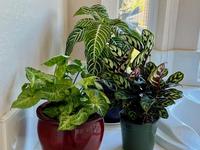
|
Sweet PeasYou have probably heard people use the "sweet peas" term incorrectly. In garden terminology, sweet peas are flowers. They are not edible and are poisonous. Edible peas, even if sweet in taste, are not correctly called sweet peas. Sweet peas are incredibly fragrant vining flowers that come in a variety of colors, mostly pastels. They are an annual flower so they must be planted again every year. You can sow seeds anytime during the winter for spring bloom. The seeds are hard and it can be helpful to nick them slightly before putting them in the ground. Sweet peas do best in full sun or light shade. The plants will decline when it gets hot outside and they will need to be removed. Remember, you cannot eat sweet peas.
|
Time to Prune Frost Damage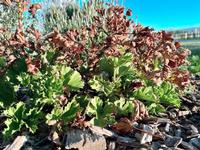
Frost damage on pelargonium
More information: Treating Cold-Damaged Plants |
Trees Planted Too Deeply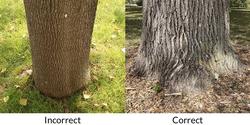
The root flare should show at the soil line. Left by David Snow, Michigan Extension, right by Sarah Browning, Nebraska Extension
More Information: Trees Planted Too Deeply |
Tropical FlowersIf you have your heart set on tropical and subtropical plants like bougainvillea and hibiscus, planting in May will give them time to get established before the cold weather hits in the fall. Planting them in a protected area such as under eaves may keep you from having to cover them on cold nights. |
USDA Hardiness ZonesPlanting zones help you select plants that are right for your garden. There are two systems, USDA and Sunset Western Garden.
USDA divides the US into hardiness zones based on average high and low temperatures. Most of Santa Clara County is in zones 9b and 10a. Sunset makes many finer distinctions, taking into consideration rainfall patterns, ocean influence, and more. In the Sunset system, Santa Clara County is largely zones 15 or 16 with some zone 7 for areas with more extreme highs and lows. Sunset zone maps: Central and South County and North County. For gardening success, choose plants known to thrive in your zone. |
Water BudgetingWe always need to use water wisely. Sometimes it is necessary to stop and think about your landscape and prioritize water use. Trees are a long-term investment, yet mature trees may have extensive root systems enabling them to find enough water on their own. Fruit trees may need watering approximately monthly during the summer in order to produce good fruit. Vegetables should always be given adequate water in order to fulfill their purpose in the garden; otherwise the little bit of water you used will have been wasted if the garden is not feeding you well. It’s helpful to understand that home-grown vegetables use much less water overall than ones purchased at the store. Established flowering shrubs, especially California natives, tend to need less water than annual flowers and maybe a more water-efficient way to have color and beauty in your garden. Lastly, keep the weeds under control so that they don’t rob water from the plants that you actually want.
More Information: Water Use Classification of Landscape Species (WUCOLS)
|
Winter IrrigationDepending on the fall weather and rain frequency, you will likely set your sprinklers to water less frequently or even turn them off for a while. It's still important to check outdoor plants to ensure they have enough water. While they need less water when it's cool, it's important to make sure they don't dry out. If you have a lawn and rains haven't come, irrigate the lawn once or twice this month. If it has been raining, the soil may be saturated, so be careful if you have to walk on it to not compact it. Also, if the soil is waterlogged, vital space for air needed for plants and worms, and excess water can drown beneficial soil organisms and contribute to rotting roots. |
Yellowing Leaves on GardeniasChlorosis is usually caused by a lack of iron in the soil. With a mild case, the veins remain green and as it becomes more severe will turn completely yellow. Treat the soil with iron chelate according the package directions. |







